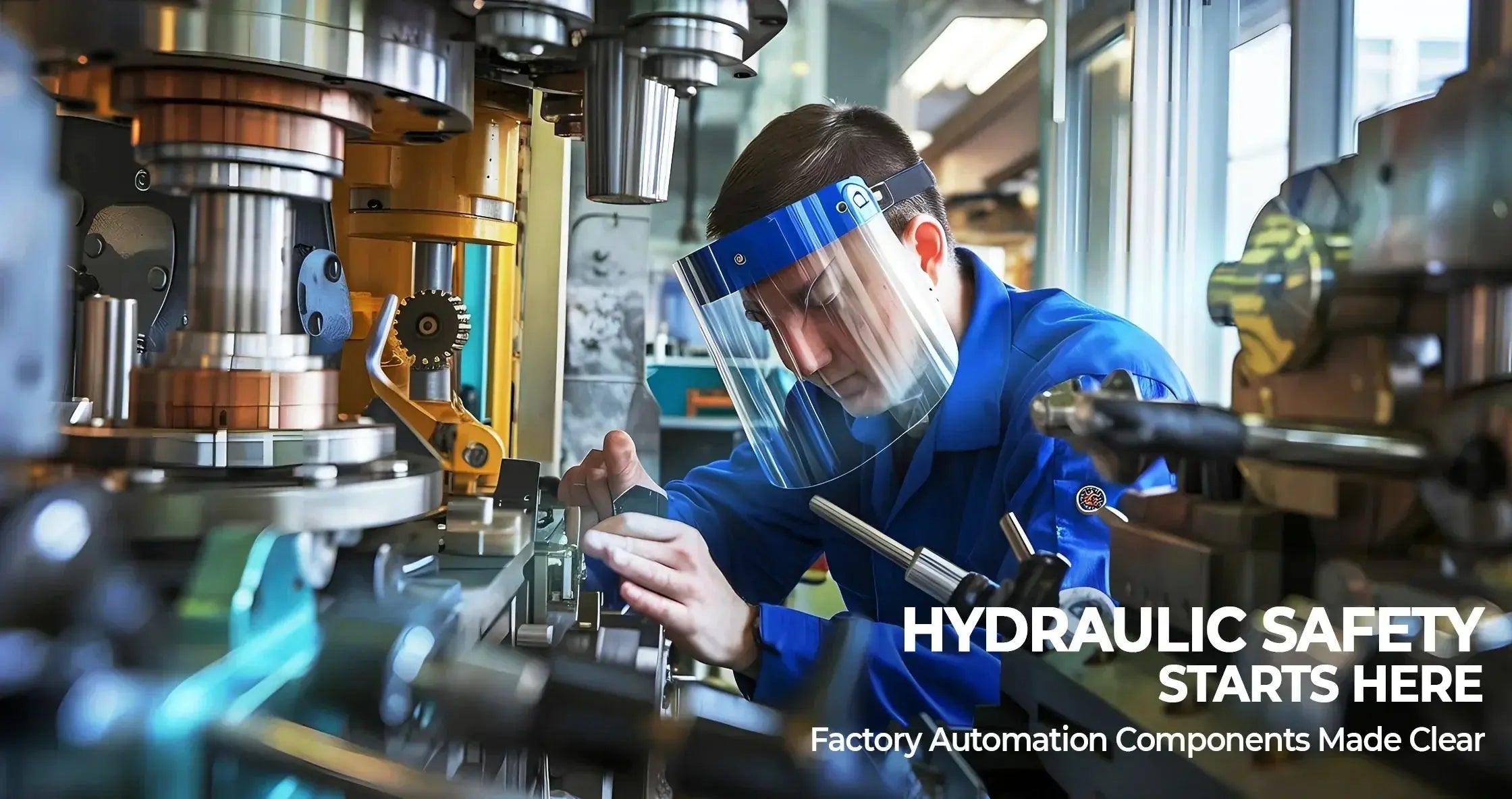Hydraulic systems are integral to many industrial, agricultural, and construction operations. From lifting heavy machinery to powering complex equipment, they offer immense force and precision. However, with great power comes great responsibility—especially when working with high-pressure systems. Hydraulic safety is not optional; it's critical. Understanding and implementing key safety measures can mean the difference between smooth operations and catastrophic accidents.
In this article, we will cover essential hydraulic safety practices, from equipment checks and pressure control to burst protection and operator training. The aim is to help you build a safer workspace and prevent injuries like hose bursts, fluid injection, and uncontrolled machinery movements.
Hydraulic Safety and the Dangers of High-Pressure Systems
Hydraulic systems typically operate under pressures ranging from 1,500 to over 10,000 psi. At these levels, even a small leak or failure can result in dangerous outcomes, including high-pressure fluid injection injuries, fire hazards, equipment failure, and loss of life.
The first step in ensuring hydraulic safety is understanding what you're dealing with. High-pressure fluid can penetrate skin, leading to severe internal damage. Unsecured hoses can whip violently, striking nearby personnel. And poorly maintained components can result in equipment collapse or uncontrolled movement.
Double-Check Hose Connections and Fittings
One of the most basic yet often overlooked hydraulic safety practices is checking hose connections. Loose or improperly fitted hoses are a major cause of hydraulic failures. Make it a habit to inspect hoses for:
- Tightness and proper seating
- Signs of wear, cracking, or bulging
- Correct pressure ratings for the application
- Proper alignment and secure clamping
Routine inspections and double-checking hose fittings before powering up any system significantly reduce the risk of leaks, bursts, and disconnections.
Lockout/Tagout Procedures: A Must for Safe Servicing
Servicing hydraulic systems without proper lockout/tagout (LOTO) procedures is a recipe for disaster. Hydraulic safety requires absolute control over the power source before performing maintenance or repairs.
Implement a standard LOTO procedure that includes:
- Shutting down the hydraulic system completely
- Isolating and locking out energy sources
- Tagging the equipment to alert others
- Verifying that the system is fully depressurized
These steps ensure the system won’t be accidentally energized while someone is working on it, preventing sudden movements or pressure surges.
Gradual Pressure Release to Avoid Hydraulic Shock
A sudden release of pressure can be just as dangerous as uncontrolled pressurization. When opening a pressurized line or component, always follow manufacturer guidelines for pressure release. Gradually releasing hydraulic pressure prevents hydraulic shock, which can cause hoses to whip or fittings to fail.
Many modern systems have built-in pressure release valves or bleed-off systems. If yours doesn’t, use appropriate tools and protective gear to slowly relieve pressure in a controlled environment.
Burst Protection: Use Whip Check Cables and Guards
Burst protection is a vital aspect of hydraulic safety. A failed hose under pressure can whip with deadly force. To mitigate this hazard:
- Install whip check cables on high-pressure hoses to anchor both ends
- Use protective hose sleeves or guards
- Avoid routing hoses near walkways or sharp edges
Whip checks not only protect workers nearby but also limit the extent of damage during a failure. Combined with regular maintenance and inspections, these protective measures significantly reduce injury risk.
Train Operators to Recognize Early Warning Signs
Hydraulic safety doesn’t rest solely on equipment; it heavily depends on human awareness. Operators and technicians must be trained to recognize warning signs of hydraulic failure, such as:
- Unusual noises (hissing, knocking, or vibration)
- Changes in system pressure or fluid flow
- Visible leaks or fluid pooling
- Slow or erratic equipment response
Early detection allows for proactive maintenance and can prevent catastrophic events. Training should be ongoing, with refreshers included in safety meetings and toolbox talks.
Personal Protective Equipment (PPE) for Hydraulic Work
Proper PPE is a frontline defense in hydraulic safety. Workers should be equipped with:
- Safety goggles or face shields
- Cut-resistant gloves
- Steel-toe boots
- Long-sleeved shirts and pants
When working around high-pressure systems, protective clothing helps minimize injury from fluid injection, burns, or contact with sharp metal edges.
Hydraulic Hose Routing Best Practices
Poor hose routing can lead to premature wear and increase the risk of failure. To improve hydraulic safety:
- Avoid sharp bends or kinks
- Provide sufficient slack to accommodate movement
- Use clamps or guides to secure hoses
- Keep hoses away from high-temperature zones and moving parts
Proper routing extends hose life and prevents accidental snagging, crushing, or bursting.
Regular Maintenance and Fluid Checks
Like any mechanical system, hydraulic systems require regular maintenance to ensure safety and performance. Implement a preventive maintenance schedule that includes:
- Checking fluid levels and quality
- Replacing worn hoses and seals
- Inspecting pumps, cylinders, and valves
- Testing relief valves and pressure gauges
Maintaining clean, properly pressurized fluid reduces wear and ensures optimal performance, reducing the likelihood of dangerous malfunctions.
Use Rated Components and Follow Manufacturer Guidelines
Not all components are created equal. Always use hoses, fittings, and valves rated for the system’s maximum pressure and temperature. Never substitute parts or exceed manufacturer specifications. Doing so compromises the integrity of the system and puts lives at risk.
Hydraulic safety requires a zero-tolerance approach when it comes to component selection and system modifications.
Real-Life Consequences: The Cost of Ignoring Hydraulic Safety
Numerous workplace accidents have occurred due to lapses in hydraulic safety. These include:
- Workers being struck by whipping hoses
- Equipment collapsing due to hydraulic failure
- Severe injuries from fluid injection
These real-life incidents underline the importance of adhering to safety protocols, training, and equipment inspections.
Conclusion: Build a Culture of Hydraulic Safety
Hydraulic systems are powerful tools, but without stringent safety practices, they can be equally dangerous. Implementing and maintaining a strong hydraulic safety protocol protects both personnel and equipment. From double-checking hose connections and using whip checks to proper lockout/tagout and operator training, every step matters.
The key takeaway: Never assume a hydraulic system is safe until it has been fully inspected, depressurized, and secured.
Explore related product collections on Industrial Electrical Warehouse to support your safety practices:
- Hydraulic Tools & Accessories – For high-performance tools and reliable components
- PPE & Safety Equipment – Ensure your team is protected
-
Pressure Gauges & Monitoring Devices – Maintain visibility and control over system conditions
A proactive approach to hydraulic safety isn’t just good practice—it’s a life-saving strategy.


